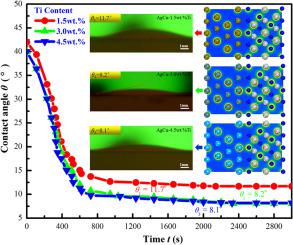Journal of Alloys and Compounds ( IF 5.8 ) Pub Date : 2021-03-02 , DOI: 10.1016/j.jallcom.2021.159323 Haifeng Xu , Yue Zhao , Jian Yang , Jihua Huang , Shuhai Chen , Zheng Ye

|
The wetting behavior and mechanism of AgCu-Xwt.%Ti filler metal on AlN ceramic were investigated using experiments and first-principles calculations. The results indicate that the interfacial ideal adhesion work of wetting interface after interfacial chemical reaction is a crucial factor influencing the wettability of AgCu-Xwt.%Ti/AlN wetting system. This factor is controlled by the interfacial bonding characteristic. AgCu/AlN ceramic is a non-reactive wetting system, which has poor wettability with a contact angle of 22.9°. When 1.5 wt.% of active element [Ti] is added in AgCuTi filler metal, interfacial chemical reaction occurs, producing TiN. Therefore, the wetting interface is composed of AgCu-1.5wt.%Ti filler metal after chemical reaction and TiN (ACTi-1/TiN interface), which exhibits a large interfacial ideal adhesion work of 9.908 J/m2, leading to a small contact angle of 11.7°. When Ti content increases to 3.0 wt.%, the ionic bonding strength of wetting interface, composed by AgCu-3.0wt.%Ti filler metal after chemical reaction and TiN (ACTi-2/TiN interface), becomes stronger than that of ACTi-1/TiN interface owing to the increasing residual Ti content. Consequently, the interfacial ideal adhesion work further increases to 9.711 J/m2, and a decreasing contact angle of 8.2° is achieved. However, when Ti content reaches to 4.5 wt.%, although residual Ti content in AgCu-4.5wt.%Ti filler metal after chemical reaction (ACTi-3) is further increased, both covalent and ionic bonding strengths of ACTi-3/TiN interface are closer to those of ACTi-2/TiN interface. This leads to an almost unchanged interfacial ideal adhesion work and contact angle of 9.753 J/m2 and 8.1°, respectively.
中文翻译:

AgCu-Xwt。%Ti填充金属/ AlN陶瓷反应性润湿系统的润湿行为和机理研究:实验和第一性原理计算
通过实验和第一性原理计算研究了AgCu-Xwt。%Ti填充金属在AlN陶瓷上的润湿行为和机理。结果表明,界面化学反应后润湿界面的界面理想附着力是影响AgCu-Xwt。%Ti / AlN润湿体系润湿性的关键因素。该因素由界面结合特性控制。AgCu / AlN陶瓷是一种非反应性润湿系统,润湿性差,接触角为22.9°。当在AgCuTi填充金属中添加1.5 wt。%的活性元素[Ti]时,发生界面化学反应,生成TiN。因此,润湿界面由化学反应后的AgCu-1.5wt。%Ti填充金属和TiN(ACTi-1 / TiN界面)组成,其界面理想的粘附力为9.908 J / m。如图2所示,导致小的接触角为11.7°。当Ti含量增加到3.0 wt。%时,由化学反应后的AgCu-3.0 wt。%Ti填充金属和TiN(ACTi-2 / TiN界面)组成的润湿界面的离子结合强度变得比ACTi-强。 1 / TiN界面归因于残余Ti含量的增加。因此,界面理想粘合功进一步提高到9.711 J / m 2,并实现了8.2°的减小接触角。但是,当Ti含量达到4.5 wt。%时,尽管化学反应(ACTi-3)后AgCu-4.5 wt。%Ti填充金属中的残留Ti含量进一步增加,但ACTi-3 / TiN的共价键和离子键强度接口更接近ACTi-2 / TiN接口。这导致几乎不变的界面理想粘合功,接触角分别为9.753 J / m 2和8.1°。











































 京公网安备 11010802027423号
京公网安备 11010802027423号